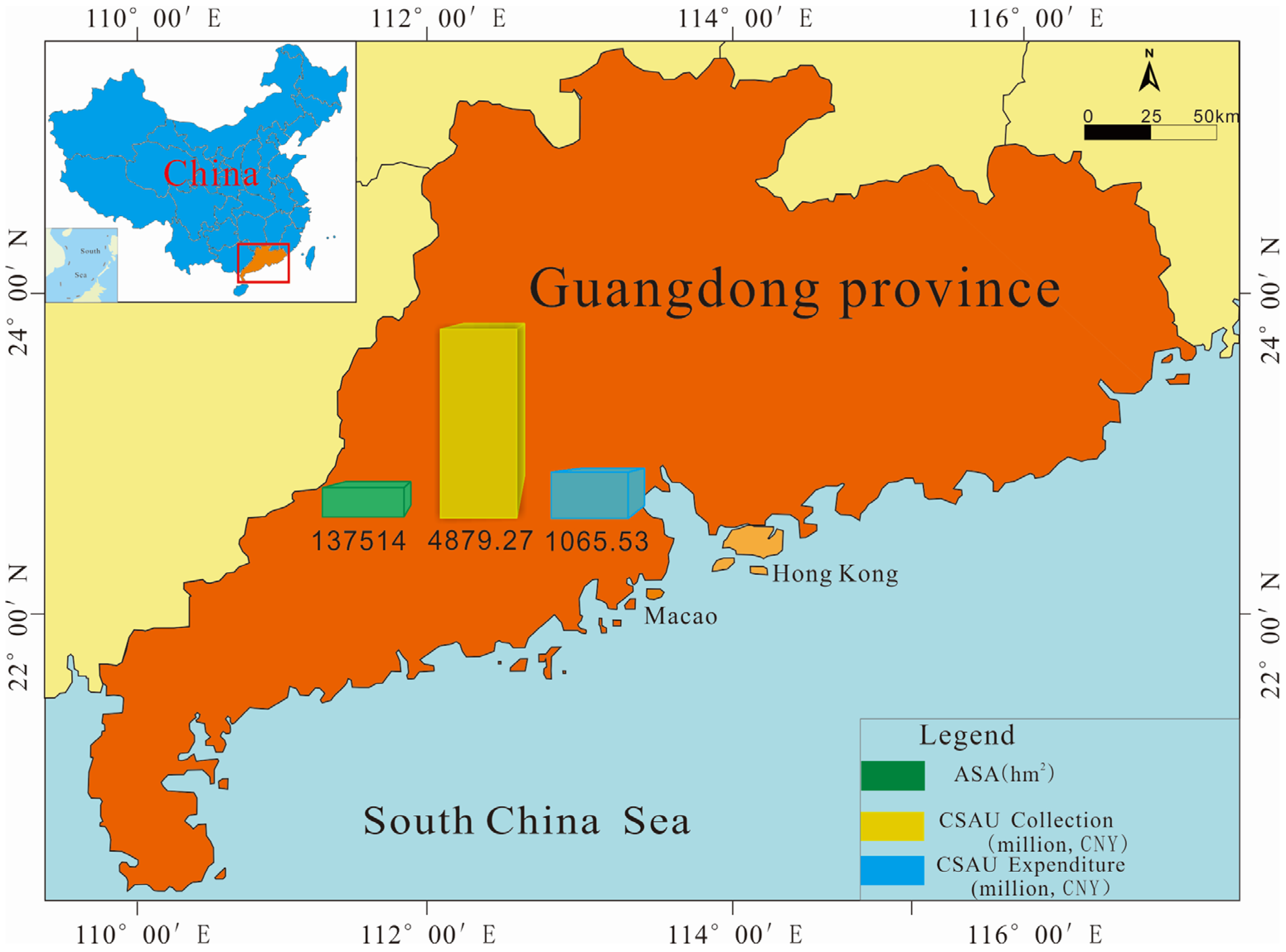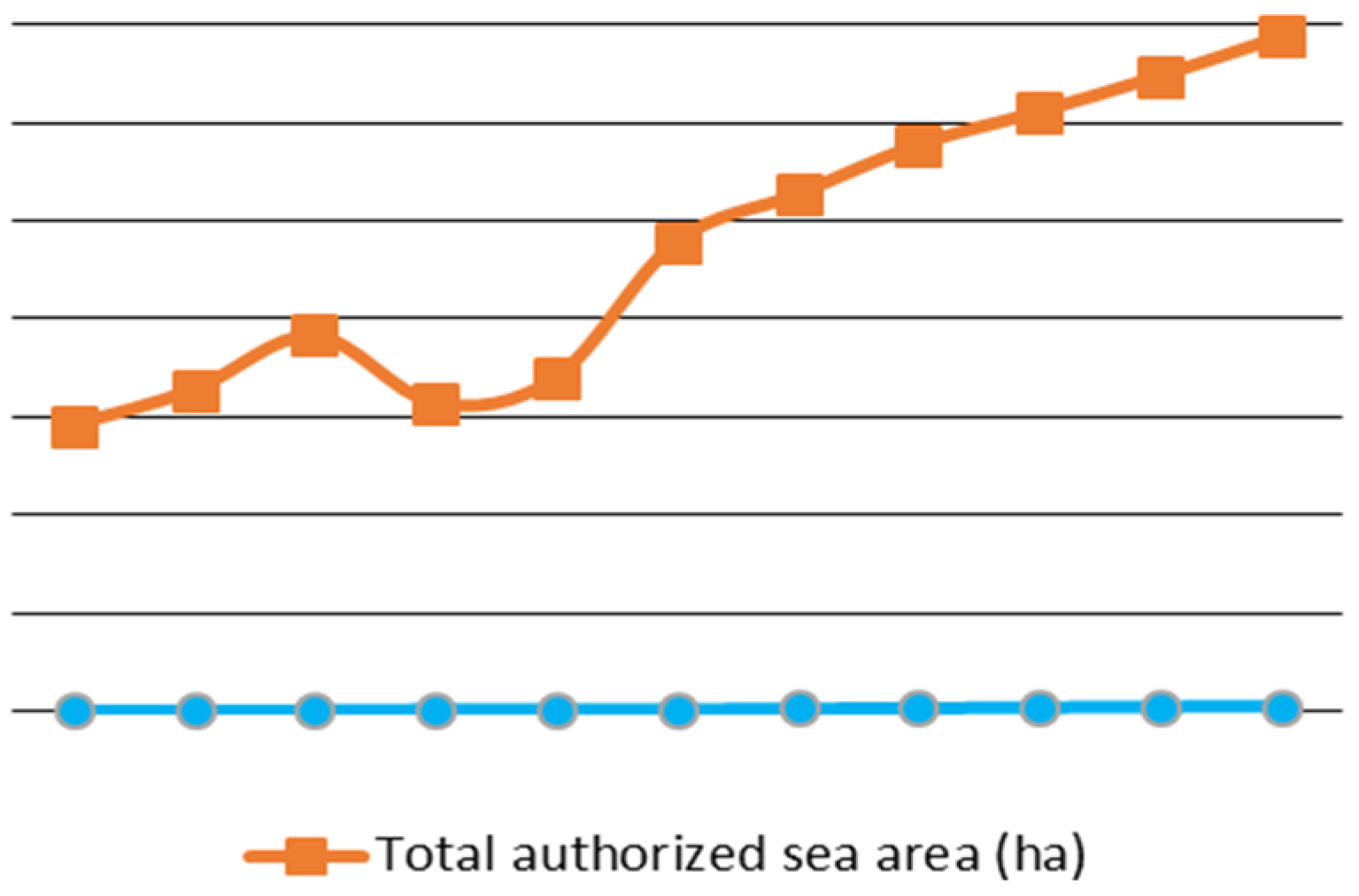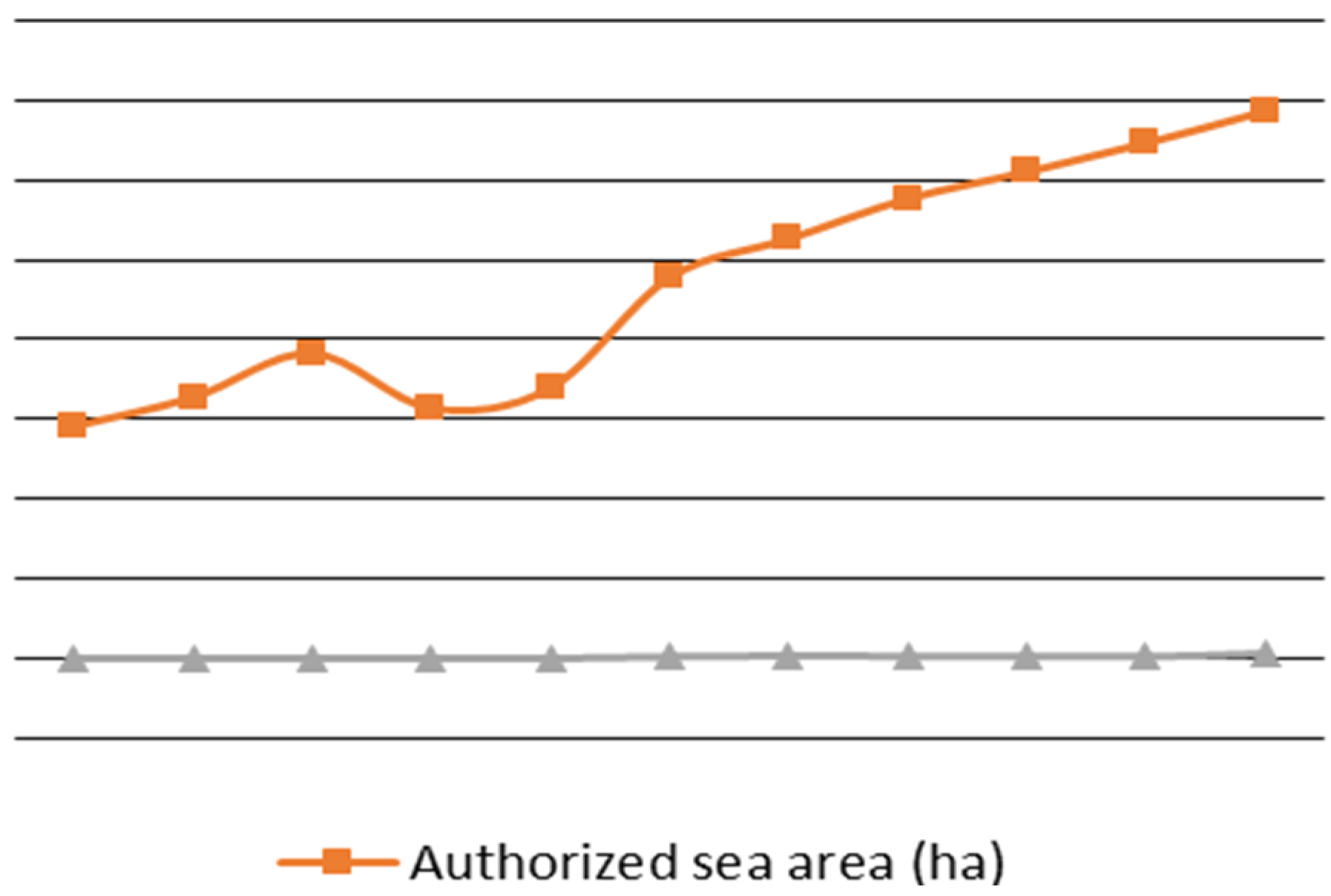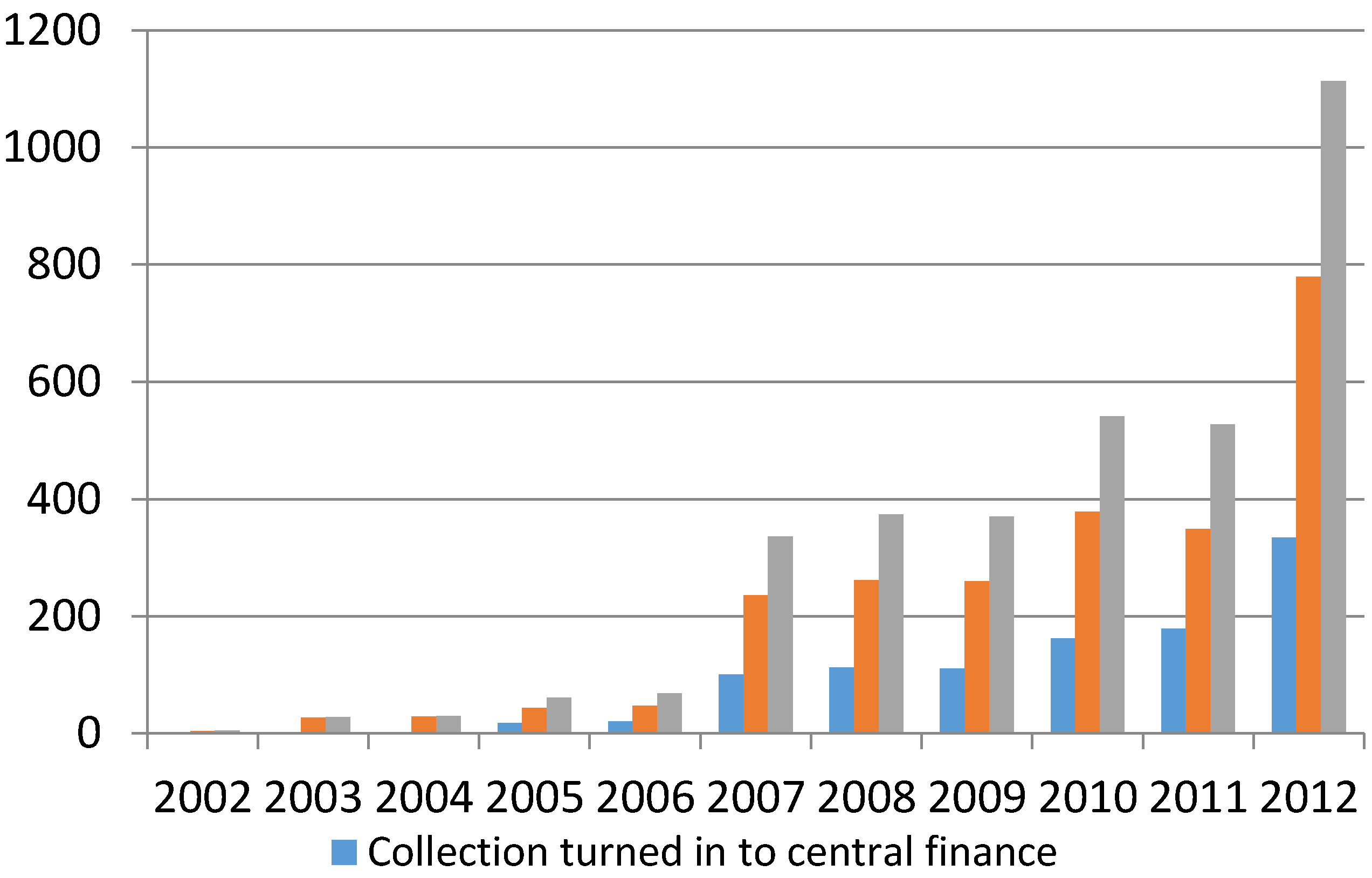Studies on Charges for Sea Area Utilization Management and Its Effect on the Sustainable Development of Marine Economy in Guangdong Province, China
Abstract
:1. Introduction
2. CSAU Collection in Guangdong Province
2.1. Current Situation of Sea Area Paid-Use Management in Guangdong Province

2.2. CSAU’s Collection in Guangdong Province
| Year | Growth of Authorized Sea Area(%) | Growth of GOP(%) | Growth of GDP in Guangdong(%) | Proportion of CSAU in Financial Revenue(‰) |
|---|---|---|---|---|
| 2002 | - | - | - | 0.03 |
| 2003 | 58.13 | 14.31 | 13.60 | 0.21 |
| 2004 | 42.37 | 53.69 | 14.20 | 0.08 |
| 2005 | 28.48 | 44.12 | 14.10 | 0.16 |
| 2006 | 20.08 | −4.07 | 14.80 | 0.05 |
| 2007 | 32.94 | 10.18 | 14.90 | 1.01 |
| 2008 | 12.70 | 28.52 | 10.40 | 1.09 |
| 2009 | 11.77 | 14.34 | 9.70 | 0.75 |
| 2010 | 7.05 | 23.91 | 12.40 | 0.78 |
| 2011 | 7.06 | 11.36 | 10.00 | 0.47 |
| 2012 | 7.24 | 14.31 | 8.20 | 1.08 |






3. CSAU Expenditure in Guangdong Province


| Year | Building Of Ocean Surveillance Ships | Sea Area And Island Renovation And Protection | Marine Economy |
|---|---|---|---|
| 2010 | 83.28 | 16.72 | 0.00 |
| 2011 | 20.31 | 75.92 | 3.77 |
| 2012 | 16.61 | 83.39 | 0.00 |
| Average | 38.51 | 60.23 | 1.27 |
| Year | Province Units | City-And-County Units | Ocean Surveillance Ship |
|---|---|---|---|
| 2010 | 21.69 | 67.91 | 10.41 |
| 2011 | 22.97 | 64.19 | 12.84 |
| 2012 | 20.72 | 59.06 | 20.21 |
| Average | 21.76 | 63.45 | 14.79 |
4. Effect of CSAU Expenditure

| Year | CSAU Collection | CSAU Expenditure | Proportion of CSAU Expenditure Against Collection |
|---|---|---|---|
| 2002 | −63.97 | - | - |
| 2003 | 467.55 | - | - |
| 2004 | 6.57 | 100.00 | - |
| 2005 | 106.44 | 94.65 | 805.85 |
| 2006 | 11.15 | 25.05 | 20.04 |
| 2007 | 392.33 | 75.30 | −17.78 |
| 2008 | 11.05 | 43.26 | 58.70 |
| 2009 | −0.88 | −3.23 | −2.27 |
| 2010 | 46.00 | 4.60 | −28.20 |
| 2011 | −2.48 | 4.72 | 7.62 |
| 2012 | 111.11 | 4.67 | −50.31 |
5. Problems in CSAU Collection and Management in Guangdong Province
5.1. Low Efficiency of Sea Area Use, and Lack of Multi-Dimensionality in CSAU Collection
5.2. Lack of Management Method in the CSAU Collection and Expenditure, and Irrational Distribution Proportion
5.3. Lack of Expenditure in the Grass-Roots Units and Inadequate Funds for Marine Affairs
5.4. Irrational Structure of CSAU Expenditure
6. Countermeasures
6.1. Establishment of Multi-Dimensional Property System for the Sea Area Resources
6.2. Perfection of the CSAU Management Policy and Bylaw
6.3. Rational Distribution of CSAU Expenditure at All Levels
6.4. Optimization of the CSAU Expenditure Structure
6.5. Enhancement of the Supervision and Management System in CSAU Expenditure
7. Conclusions
Acknowledgments
Author Contributions
Conflicts of Interest
References
- Pioch, S.; Saussola, P.; Kilfoyleb, K.; Spieler, R. Ecological design of marine construction for socio-economic benefits: Ecosystem integration of a pipeline in coral reef area. Procedia Environ. Sci. 2011, 9, 148–152. [Google Scholar] [CrossRef]
- Basurko, O.C.; Mesbahi, E. Methodology for the sustainability assessment of marine technologies. J. Clean. Prod. 2014, 68, 155–164. [Google Scholar] [CrossRef]
- Visbeck, M.; Kronfeld-Goharani, U.; Neumann, B.; Rickels, W.; Schmidt, J.; van Doorn, E.; Matz-Lück, N.; Ott, K.; Quaas, M.F. Securing blue wealth: The need for a special sustainable development goal for the ocean and coasts. Mar. Pol. 2014, 48, 184–191. [Google Scholar] [CrossRef]
- Mingli, Z.; Dewei, Y.; Ping, W.; Ping, S. A market-based approach to marine sand resource management in the Pearl River estuary, China. Ocean Coast Manag. 2015, 105, 56–64. [Google Scholar]
- Cao, L.; Tian, H.; Yang, J.; Shi, P.; Lou, Q.; Waxi, L.; Ni, Z.X.; Peng, X.J. Multivariate Analyses and Evaluation of Heavy Metals by Chemometric BCR Sequential Extraction Method in Surface Sediments from Lingdingyang Bay, South China. Sustainability 2015, 7, 4938–4951. [Google Scholar] [CrossRef]
- Department Of Finance of Guangdong Province. Regulate the management of sea area use charges’ collection and expenditure to push forward marine economy’s rapid development. China Finance. 2011, 17, 60–61. [Google Scholar]
- Zhang, S.; Wang, M. Implement and improvement of sea area paid-use system in China. Economic Aspect 2015, 1, 33–37. [Google Scholar]
- State Oceanic Administration People’s Republic of China. Sea Area Management Bulletin (2002–2012). Available online: http://www.soa.gov.cn/zwgk/hygb/ (accessed on 10 May 2014). (In Chinese)
- State Oceanic Administration People’s Republic of China. China Marine Statistical Yearbook; 2003–2013; China Ocean Press: Beijing, China, 2003–2013. (In Chinese)
- Statistics Bureau of Guangdong Province. Guangdong Statistical Yearbook; 2013; China Statistics Press: Beijing, China, 2013.
- Zhang, S. The Influence Study on Sea Area Use to Marine Economy Growth in our Country. Master’s Thesis, Ocean University of China, Qingdao, China, 2014. [Google Scholar]
- Mao, X.F. The problems in sea area use charges collection and management and the countermeasure. Financial superv. 2007, 3, 32–33. [Google Scholar]
- Xu, X.M.; Mei, F.; Shi, J. Sea Area Paid-Use System in China; China Environment Science Press: Beijing, China, 2009. [Google Scholar]
- Pan, X.C. Introduction to Sea Area Governance; Ocean Press: Beijing, China, 2014. [Google Scholar]
- Gao, Z.G. China’s Ocean Development Report 2015; Ocean Press: Beijing, China, 2015. [Google Scholar]
- Reshaping the Governance for Sustainable Development. China Sustainale Development Report 2015; Science Press: Beijing, China, 2015. [Google Scholar]
- Zhang, S.; Wang, M. Sea Area Utlization Charge Management’s Effect in China and its Analysis. Price theory Pract. 2015, 1, 62–64. [Google Scholar]
- Xiang, X.M. An Evaluation of the Competitivity of Guangdong Maritime Economy. China Open. J. 2013, 1, 14–19. [Google Scholar]
- Yang, L.J. Financial Routes and Countermeasures on the Construction of Marine Economically Strong Province—Taking Guangdong Province as Example. Local financial resear. 2013, 11, 63–68. [Google Scholar]
- The Central People’s Government of the People’s Republic of China. Regulation on the Management of Collection and Expenditure from the Transfer of State-owned Lands. Availalbe online: http://www.gov.cn/gongbao/content/2007/content_503389.htm (accessed on 11 June 2014).
- Ministry of Finance. National Land Use Right Paid-Use Charges Management Provisional Regulation, China, 1989; Coucil of State City: Beijing, China, 1989. (In Chinese)
- Yu, G.A. Research on the Financial Hot Issues; Economic Science Press: Beijing, China, 2011. [Google Scholar]
© 2016 by the authors; licensee MDPI, Basel, Switzerland. This article is an open access article distributed under the terms and conditions of the Creative Commons by Attribution (CC-BY) license (http://creativecommons.org/licenses/by/4.0/).
Share and Cite
Yang, L.; Wang, P.; Cao, L.; Liu, Y.; Chen, L. Studies on Charges for Sea Area Utilization Management and Its Effect on the Sustainable Development of Marine Economy in Guangdong Province, China. Sustainability 2016, 8, 116. https://doi.org/10.3390/su8020116
Yang L, Wang P, Cao L, Liu Y, Chen L. Studies on Charges for Sea Area Utilization Management and Its Effect on the Sustainable Development of Marine Economy in Guangdong Province, China. Sustainability. 2016; 8(2):116. https://doi.org/10.3390/su8020116
Chicago/Turabian StyleYang, Lijing, Ping Wang, Linglong Cao, Yongjian Liu, and Lei Chen. 2016. "Studies on Charges for Sea Area Utilization Management and Its Effect on the Sustainable Development of Marine Economy in Guangdong Province, China" Sustainability 8, no. 2: 116. https://doi.org/10.3390/su8020116
APA StyleYang, L., Wang, P., Cao, L., Liu, Y., & Chen, L. (2016). Studies on Charges for Sea Area Utilization Management and Its Effect on the Sustainable Development of Marine Economy in Guangdong Province, China. Sustainability, 8(2), 116. https://doi.org/10.3390/su8020116





